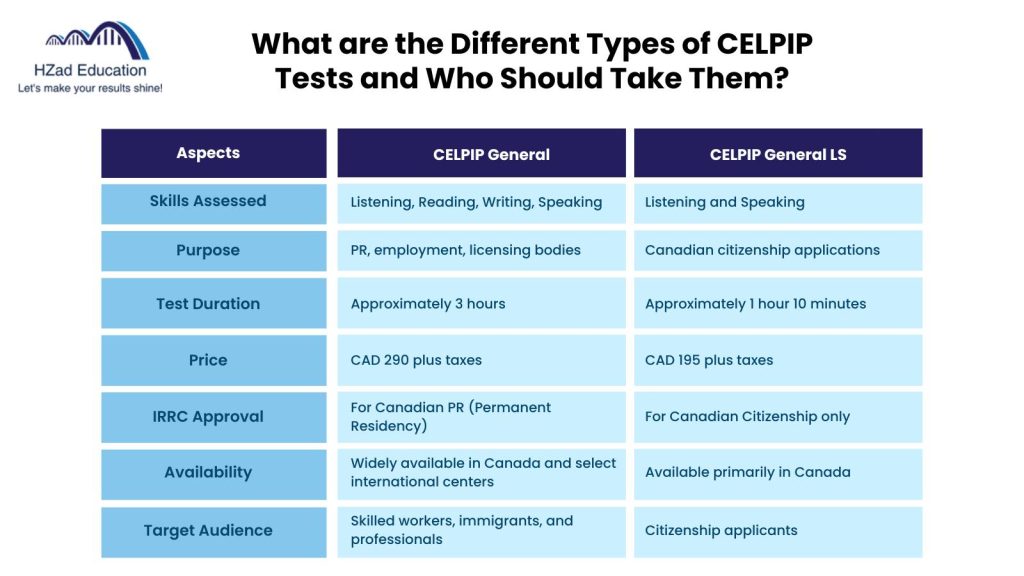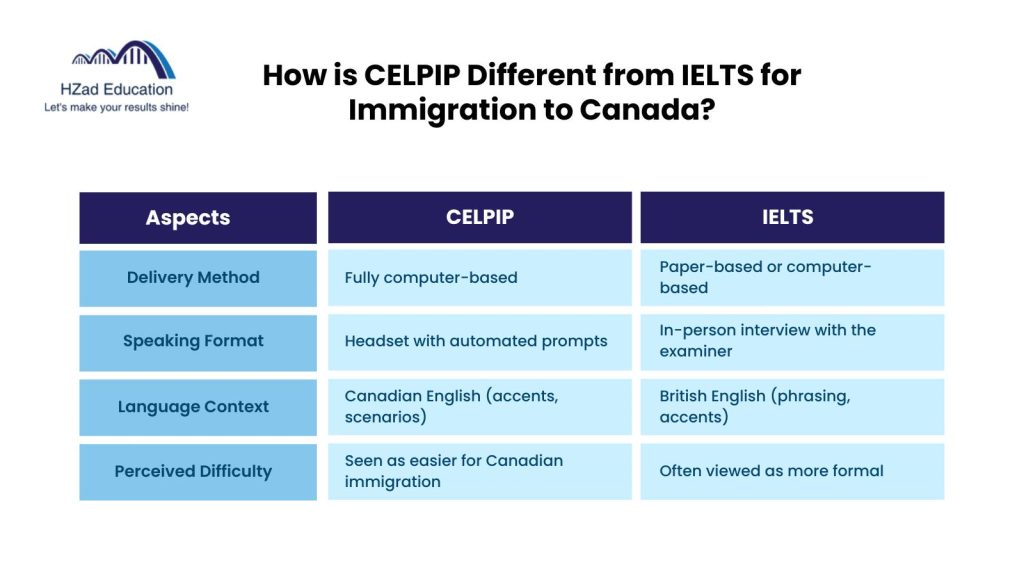For many newcomers to Canada, demonstrating English ability is more than a requirement. It is the key to unlocking opportunities such as Permanent Residency, Citizenship, or professional licensing. The CELPIP test is one of the most widely trusted options because it is officially accepted by Immigration, Refugees and Citizenship Canada (IRCC).
Beyond immigration, CELPIP scores are also used by universities and professional bodies, making the exam relevant for students, workers, and skilled professionals alike. Since the test is completed entirely on a computer and results are released quickly, many candidates choose it as a practical alternative to other language assessments.
This guide explains every major aspect of CELPIP, including the different test types, section structure, scoring and CLB levels, comparisons with IELTS, preparation strategies, and retake policies. By the end, you will have a clear roadmap to approach the exam with confidence.
What is the CELPIP Test and Why is it Important?
The CELPIP test is a computer-delivered English language assessment for permanent residency, citizenship, employment, and education in Canada. The Canadian English Language Proficiency Index Program (CELPIP) evaluates test takers’ communication skills in speaking, listening, reading, and writing in the Canadian context.
Because the test is fully computer-based, all sections are completed in a single sitting and responses are scored consistently. Results are typically released within four to five business days, giving applicants the ability to move forward with immigration or study plans without delay.
CELPIP’s importance comes from its official recognition. It is accepted by Immigration, Refugees and Citizenship Canada (IRCC) for both Permanent Residency and Canadian Citizenship applications. In addition, universities and professional licensing bodies recognize CELPIP scores as standardized proof of English ability, making it valuable for academic and career pathways.
With its Canadian focus, quick turnaround time, and wide acceptance, CELPIP has become a preferred choice for thousands of candidates each year. Its growing popularity reflects both the trust institutions place in the exam and the convenience it offers to test takers worldwide.
What are the Different Types of CELPIP Tests and Who Should Take Them?

Different types of CELPIP tests are CELPIP General and CELPIP General LS. The CELPIP-General assesses Listening, Reading, Writing, and Speaking for Permanent Residency and employment pathways, while the CELPIP-General LS measures only Listening and Speaking for Canadian Citizenship applications.
The General test is designed for applicants who must demonstrate full language proficiency to qualify for immigration or professional purposes, while the General LS test is a shorter option tailored for individuals whose primary requirement is to show oral communication skills for Citizenship.
| Aspects | CELPIP General | CELPIP General LS |
| Skills Assessed | Listening, Reading, Writing, Speaking | Listening and Speaking |
| Purpose | PR, employment, licensing bodies | Canadian citizenship applications |
| Test Duration | Approximately 3 hours | Approximately 1 hour 10 minutes |
| Price | CAD 290 plus taxes | CAD 195 plus taxes |
| IRRC Approval | For Canadian PR (Permanent Residency) | For Canadian Citizenship only |
| Availability | Widely available in Canada and select international centers | Available primarily in Canada |
| Target Audience | Skilled workers, immigrants, and professionals | Citizenship applicants |
CELPIP General
CELPIP General is a four-skill English language assessment designed for immigration and professional purposes in Canada. It evaluates four key language skills: Listening, Reading, Writing, and Speaking to provide a complete measure of English ability in real-life contexts.
Since it is officially recognized by Immigration, Refugees and Citizenship Canada (IRCC) and other Canadian immigration bodies, this test is the standard choice for most applicants seeking to settle and work in Canada. It is commonly taken by skilled workers, international graduates, and professionals who must meet Canadian Language Benchmark (CLB) requirements. Compared with IELTS General Training, CELPIP is fully computer-based and reflects Canadian English usage, which makes it a practical option for many candidates.
CELPIP General LS
CELPIP General LS is a two-skill English test used exclusively for Canadian citizenship. Unlike the full General version, it measures only Listening and Speaking skills, focusing on a candidate’s ability to understand and communicate effectively in English.
This version is officially recognized by Immigration, Refugees and Citizenship Canada (IRCC) as fulfilling the language requirement for citizenship applications. With a shorter duration and simpler format, it is designed for applicants who do not need to demonstrate reading or writing ability. For many individuals, CELPIP General LS offers a direct and efficient way to meet the English requirement for Canadian Citizenship while ensuring the test reflects real-life communication in a Canadian context.
How is the CELPIP Test Structured?
The CELPIP test is a computer-based exam with four sections: Listening, Reading, Writing and Speaking. Each measures real-life English communication skills, from understanding conversations to producing written and spoken responses. The test is completed in one sitting, lasts about 2 hours and 50 minutes, and results are delivered in 3-4 business days.
Listening Section
The listening component of the CELPIP test evaluates comprehension of everyday Canadian English through audio-based tasks. It begins with a short practice set and continues with six parts (38 questions), each designed to test different skills. Question types include:
- Identifying opinions
- Understanding key information
- Recognizing details
- Interpreting conversations or discussions
Candidates complete this section using headphones, which creates a controlled environment that simulates real-life listening situations and ensures fairness across test centers. The total time for the Listening section is about 46 to 50 minutes, giving candidates enough exposure to varied accents and contexts while measuring their ability to follow spoken English in both casual and professional settings.
Reading Section
The reading section assesses the candidate’s ability to understand and interpret written English texts. It is divided into several parts (38 questions), including reading correspondence such as emails or letters, analyzing diagrams, interpreting informational passages, and evaluating viewpoints. Question types focus on:
- Choosing the best response
- Identifying key details
- Understanding tone or attitude within the text
This section is designed to reflect real-life reading tasks that candidates may encounter in daily, academic, or workplace settings. The time frame for the Reading section ranges from 43 to 56 minutes, requiring test takers to manage their pacing carefully while demonstrating both accuracy and comprehension.
Writing Section
In the writing section, test takers must complete two tasks and express their ideas in written English. The first is an email that assesses the ability to communicate formally and appropriately in everyday situations, and the second is an opinion-based response that evaluates how well candidates can present ideas clearly and logically.
Both tasks are scored on clarity, coherence, vocabulary use, and grammar accuracy. Responses are usually expected to be 150 to 200 words, which requires candidates to organize their thoughts within a set length. The section is typed on a computer and has a total time of 53 minutes, giving test takers the chance to demonstrate effective written communication in practical Canadian contexts.
Speaking Section
The CELPIP speaking section is a computer-recorded assessment with no live interviewer. It is divided into eight parts with an equal number of questions that include tasks such as giving advice, describing scenes, making predictions, and expressing personal opinions.
Each response is timed and recorded through a headset, ensuring consistency across all test takers. This setup reduces the pressure of face-to-face interaction while still measuring how effectively candidates can communicate in English. The entire Speaking section takes about 15 to 20 minutes to complete, making it one of the shorter but highly important parts of the test.
How Does CELPIP Scoring Work and What Do CLB Levels Mean?
CELPIP scores range from 1 to 12 and match the Canadian Language Benchmarks (CLB) used to measure language ability nationwide. Immigration programs such as Express Entry often require CLB 7 or higher, while Citizenship may need a lower level. Each skill is scored separately, and results remain valid for two years.
CELPIP Score Chart
The CELPIP Score Chart provides a clear breakdown of performance levels, ranging from 1 to 12. Each score reflects how effectively a candidate can use English in real-life situations, from very limited skills at the lower end to advanced proficiency at the highest levels. Understanding this scale helps test takers set preparation goals and know what level of ability is expected for different purposes, such as immigration, study, or professional use.
| CELPIP Score | Language Proficiency Description |
| 12 | Expert proficiency in workplace and community contexts |
| 11 | Advanced professional fluency and comprehension |
| 10 | High proficiency in demanding professional tasks |
| 9 | Effective proficiency in workplace communication |
| 8 | Good proficiency for most daily life activities |
| 7 | Adequate proficiency for basic work and community interactions |
| 6 | Developing proficiency for familiar situations |
| 5 | Acquiring basic language skills for everyday use |
| 4 | Adequate proficiency in daily life activities |
| 3 | Some proficiency in communication |
| 2 | Limited ability to convey immediate needs |
| 1 | Insufficient information to access |
| 0 | Insufficient information to access |
CLB Equivalency
CELPIP scores are directly mapped to the Canadian Language Benchmarks (CLB), which serve as the national standard for describing language proficiency in Canada. This equivalency helps applicants understand how their CELPIP results meet immigration or citizenship requirements. For example, many Express Entry programs require a minimum of CLB 7 for the Federal Skilled Worker Program, while Citizenship applications may only need a lower level. The chart below shows the official CELPIP to CLB conversion.
| CELPIP Score | CLB Level |
| 12 | CLB 12 |
| 11 | CLB 11 |
| 10 | CLB 10 |
| 9 | CLB 9 |
| 8 | CLB 8 |
| 7 | CLB 7 |
| 6 | CLB 6 |
| 5 | CLB 5 |
| 4 | CLB 4 |
| 3 | CLB 3 |
| 2 | CLB 1, 2 |
| 1 | – |
| 0 | – |
Score Descriptors
The CELPIP score descriptors give qualitative meaning to the numeric scale, showing what a score actually represents in real-life English use. Instead of being just numbers, descriptors explain the level of fluency, accuracy, and communication ability demonstrated by a candidate.
Key examples of score descriptors include:
- Level 12: Advanced command of English in workplace and community contexts
- Level 9: Strong fluency and accuracy suitable for professional communication
- Level 7: Adequate proficiency for most daily and work-related needs
- Level 5: Basic ability limited to familiar situations
- Level 3 or below: Minimal communication ability with frequent difficulty understanding
These descriptors help test takers interpret their strengths and weaknesses more clearly. Each section, Listening, Reading, Writing, and Speaking, has its own rubric, ensuring that performance is assessed consistently across different skills.
How is CELPIP Different from IELTS for Immigration to Canada?

CELPIP is fully computer-based and uses Canadian English, while IELTS can be taken on paper or computer and often reflects British English. Both tests are officially accepted by Immigration, Refugees and Citizenship Canada (IRCC) for immigration and citizenship applications, but their delivery and experience differ in important ways.
CELPIP delivers all sections on a computer and records speaking responses through a headset, while IELTS allows paper or computer testing and uses a live interview for speaking. Many candidates find CELPIP more approachable because of its Canadian context and faster, consistent format, whereas IELTS can feel more formal due to examiner interaction and British phrasing. The following CELPIP vs IELTS comparison highlights these core differences.
| Aspect | CELPIP | IELTS |
| Delivery Method | Fully computer-based | Paper-based or computer-based |
| Speaking Format | Headset with automated prompts | In-person interview with the examiner |
| Language Context | Canadian English (accents, scenarios) | British English (phrasing, accents) |
| Perceived Difficulty | Seen as easier for Canadian immigration | Often viewed as more formal |
Difficulty Level
Both CELPIP and IELTS are valid English language tests, but many test-takers perceive their difficulty differently. CELPIP is often considered easier because it is fully computer-based, features Canadian English accents, and uses familiar everyday scenarios. IELTS, on the other hand, can feel more challenging due to its use of British English phrasing, wider vocabulary range, and the face-to-face speaking interview.
While some candidates prefer CELPIP for its consistent format and Canadian focus, others may perform better with IELTS depending on their language background and comfort level. Ultimately, the perceived difficulty of each test is subjective and depends on individual strengths and familiarity with the test format.
Speaking Format Differences
The main difference in the speaking format is that CELPIP is computer-recorded while IELTS involves a live interview. In CELPIP, candidates respond to pre-recorded prompts using a headset, ensuring consistency and reducing pressure for those who are uncomfortable with face-to-face interviews. IELTS, by contrast, requires speaking directly with an examiner, offering real-time interaction that some test takers may find more natural but others may find intimidating.
CELPIP’s approach appeals to candidates who prefer a standardized, technology-driven process, while IELTS speaking allows for conversational flow and immediate clarification. These contrasting formats mean that the better choice often depends on whether a candidate feels more confident speaking to a computer or to a person.
Computer-based vs Paper
A key difference between the two exams is that CELPIP is delivered only on a computer, while IELTS can be taken on either paper or a computer. CELPIP’s format allows candidates to type responses, which makes editing and time management easier for those comfortable with keyboards. IELTS, by contrast, offers handwriting for paper-based tests, which may be preferred by candidates used to traditional exams but can slow down response time.
The IELTS computer version provides typing, but the interface varies slightly by location, while CELPIP maintains a uniform and consistent system across all centers. For many test takers, the choice comes down to whether they are more confident typing answers or writing them by hand.
How Can You Effectively Prepare for the CELPIP Test?
You can prepare for the CELPIP test using practice tests, study materials, tutoring support, and time management techniques. Whether preparing for the CELPIP General or CELPIP General LS, combining these methods creates a balanced approach. Regular practice builds confidence, while targeted support strengthens weaker areas such as writing or speaking. By focusing on strategies that match your learning style, you can enter the test with clarity and readiness.
Practice Tests
Preparing with practice tests helps candidates understand the structure of the CELPIP exam and build the confidence needed for test day. Both free and paid options are available online, giving candidates access to different levels of preparation. These include full-length mock exams that mirror the three-hour test experience and section-specific drills that focus on Listening, Reading, Writing, or Speaking individually.
To get the most value, test takers should recreate the official test environment by using a headset, following strict time limits, and practicing in a quiet space. This approach improves pacing, reduces anxiety, and ensures candidates are ready for the computer-based format.
Study Materials
A wide range of study materials is available to support CELPIP preparation, from official guidebooks and eBooks to online prep courses, videos, and mobile apps. Candidates can choose between self-paced resources, such as PDFs and recorded lessons, or structured programs that provide step-by-step guidance. Official CELPIP materials are especially valuable because they reflect the test format and scoring criteria, giving learners reliable practice.
Free resources like YouTube tutorials and sample questions can supplement study, but using IRCC-recognized or CELPIP-official sources ensures accuracy. By combining different formats, whether reading a study guide, completing online exercises, or practicing with interactive apps, candidates can strengthen their skills and prepare more effectively.
Tutoring Services
Tutoring for CELPIP is available in different formats, including one-on-one coaching, group sessions, and online classes. Tutors help candidates strengthen their preparation by teaching test strategies, improving time management, and addressing weaker skills such as speaking or writing. Support is provided by both established test prep centers and freelance language coaches, giving learners flexibility in how they prepare.
A key advantage of tutoring is the personalized feedback it offers, especially for written responses and recorded speaking tasks. Many students choose structured CELPIP classes, which combine expert instruction with targeted practice to build confidence and raise scores more effectively than self-study alone.
Time Management
Time control is essential for success in the CELPIP test because every section has strict limits that must be followed. Common pitfalls include running out of time, rushing through answers, or overthinking tasks, all of which reduce accuracy.
To manage pacing better, candidates should allocate time per section, stick to word and answer limits, and use mock tests to practice under timed conditions. These habits make it easier to complete tasks efficiently while maintaining quality. Tracking performance over multiple practice sessions also helps identify whether improvements in speed and accuracy are consistent. Developing these strategies before test day ensures candidates can handle the pressure and perform more confidently.
What are the CELPIP Retake Rules and Re-evaluation Options?
The CELPIP retake rules require candidates to redo the entire test, as section-only retakes are not permitted. A minimum waiting period of 4 days is enforced between test sittings, which allows results to be processed properly.
For scheduling flexibility, candidates can reschedule the CELPIP test. Paragon Testing Enterprises allows changes to the test date, time, or location if the request is made at least 7 calendar days before the original booking. The first transfer is free, while any additional changes cost CAD 50 plus applicable taxes.
In addition, CELPIP offers a re-evaluation option for the Writing and Speaking sections. Test takers who feel their score does not reflect their performance may request this review, though results may remain unchanged, and fees apply (CAD 55 valid within six months).
These policies matter for applicants aiming to meet immigration requirements. For example, a candidate who needs to raise their score from level 6 to level 7 for eligibility will need to retake the full test after the waiting period or consider a re-evaluation if only one skill area seems affected.
Which Institutions and Programs Accept CELPIP Scores?
CELPIP scores are accepted by Immigration, Refugees and Citizenship Canada (IRCC), Canadian universities, and professional licensing bodies as proof of English proficiency. Immigration authorities use CELPIP for Permanent Residency and Citizenship, universities may require them for admission, and licensing boards in fields such as healthcare or accounting use them to validate professional communication. Score requirements vary depending on the pathway, so applicants should confirm the specific minimum score set by the institution or authority.
IRCC Acceptance
CELPIP is officially accepted by Immigration, Refugees and Citizenship Canada (IRCC) for both immigration and citizenship applications. It meets the English language requirements for programs such as Express Entry, where applicants often need a minimum score equal to CLB 7 for NOC TEER 0 or 1, and for Canadian Citizenship, where the CELPIP-General LS is sufficient at a lower level. The CELPIP-General Test is required for Permanent Residency, while the CELPIP-General LS Test is used for Citizenship. Minimum scores vary depending on the program, so candidates should confirm the latest requirements on the IRCC website before registering.
Universities & Professional Bodies
CELPIP scores are also recognized by several Canadian universities and professional licensing bodies. In higher education, some institutions accept CELPIP results as proof of English proficiency for academic admission, while professional organizations in fields such as nursing, accounting, and engineering use them to assess communication skills for certification or licensing.
Requirements vary across institutions, with academic programs often asking for higher levels than immigration pathways. Because policies differ, applicants should always verify the specific score criteria with the university or regulatory body. Acceptance of CELPIP in both education and professional sectors continues to grow, making it an increasingly valuable credential for newcomers.
Test Centers
CELPIP test centers are located across Canada and in multiple countries worldwide. Outside Canada, popular locations include India, the United Arab Emirates, the Philippines, and the United States, making the exam accessible to international applicants. All test centers follow standardized procedures to ensure fairness and consistency, regardless of location. Availability may vary depending on city and demand, so candidates are encouraged to check the official CELPIP website for the most up-to-date list of centers and to book their preferred date and location in advance.
Frequently Asked Questions about CELPIP
Which CELPIP test do I need for PR or Citizenship?
For Permanent Residency, you must take the CELPIP-General Test, which covers Listening, Reading, Writing, and Speaking. For Canadian Citizenship, the CELPIP-General LS Test is required, measuring only Listening and Speaking. Always confirm the requirements with IRCC before registering.
Is CELPIP easier than IELTS?
Many test takers find CELPIP easier because it is fully computer-based, uses Canadian English accents, and reflects everyday situations. IELTS can feel more formal due to British phrasing and its face-to-face speaking interview. Difficulty, however, is subjective and depends on a candidate’s skills and comfort level.
Can I retake only one section of CELPIP?
No, CELPIP does not allow section-only retakes. If you need to improve your score, you must retake the full test after a minimum waiting period of 4 days. Re-evaluation requests are possible for Writing and Speaking, but not for Listening or Reading.
What should I select as an institution for the CELPIP exam?
If you are applying for Permanent Residency or Citizenship, select IRCC as the receiving institution when booking your CELPIP test. For academic programs or professional licensing, choose the specific university or regulatory body to ensure your scores are sent directly to them.
Where can I take CELPIP outside Canada?
CELPIP is available at international test centers in countries such as India, the UAE, the Philippines, and the United States. All centers follow the same testing protocols as those in Canada. Visit the official CELPIP website to check the latest availability and book your location.


